 |
| Has anyone ever seen Chris Gaines and Taylor Swift in the same room? |
As previously mentioned, I personally went several years without listening to much country music but I found a new respect for the form thanks largely to artists like Lydia Loveless. Lydia grew up surrounded by country music before she spent a few years in the punk scene of Ohio. Then she combined the two forms seamlessly, showing the creative potential for country music, garnering critical acclaim, and becoming one of my favorite musicians in the process (for what that's worth). That's what I would like to see from Taylor. She has clearly changed a lot over the past few years and I would like to see the new Swift merge with the old to create something entirely different and unique, but I think Taylor may be done with country for quite a while.
One significant difference between Swift and Loveless and Brooks is that Taylor has been inching towards pop for years. Her 2012 album Red was noticeably more pop than country, featuring collaborations with hit making producer Max Martin. Still, I never thought she would burn the bridge to country until the music video for 1989's "Bad Blood". The basic concept of "Bad Blood" is getting Taylor's famous friends together so they can do cool action movie stuff and not one of those friends is a country singer.
It's not like there's a shortage of badass women in country music. Miranda Lambert has built a career on strutting all cool like and burning things. Recently she and Carrie Underwood robbed a bank together in their own action movie homage. The only thing stopping Brandy Clark from killing her cheating beau is that she hates stripes and fifteen years earlier the Dixie Chicks decided it was worth the risk to take out a domestic abuser. Around that time Shania Twain was in her own CGI sci-fi music video. Before most of these women and the one's in "Bad Blood" (and some of them's parents) were even born Loretta Lynn was threatening to take homewreckers to "Fist City" and getting kicked off the radio for promoting contraception. The first part especially might not be relevant to modern feminism but it was badass as heck.
Another country candidate for "Bad Blood" is Faith Hill, who might not have a lot of badass credential but Taylor named her song "This Kiss" as one of her biggest influences in Rolling Stone. She emphasized the crossover appeal but it's still probably the most significant acknowledgement of her country past that Taylor has made in a year or more. Make no mistake, Taylor's past was full of country. Her first hit was named after Hill's husband and fellow country superstar Tim McGraw. Her first album is full of rural imagery like screen doors and pick up trucks. On her third album's "Mean" she even threw in a little bluegrass.
In that song Taylor revealed that her ambition was to live in a "big ol' city," because staying in the styx isn't good enough. This is probably the least country thing about Taylor Swift. Country singers tend to love the country and despise the city. It's one of the most frustrating cliche's of the genre. For instance, "Homeboy" from Eric Church's otherwise excellent album Chief the city is associated with "hip hop hats," saggy pants, and cussing at and physically accosting your parents while the country is associated with trucks and beer and high school sweethearts. If the only way Taylor can grow as an artist is to leave overly simplistic stereotypes like that behind than I only look forward to what comes next. However, in my experience country can be much more complex than that. It can be a Gaga-esque ode to self love, or political (and not necessarily conservative), or personal and passionate, or, believe it or not, even upbeat and cheerful. It would be a shame if country loses Taylor Swift forever but it will be alright without her.






2.jpg/revision/latest?cb=20110421014809)


_001.jpg)





